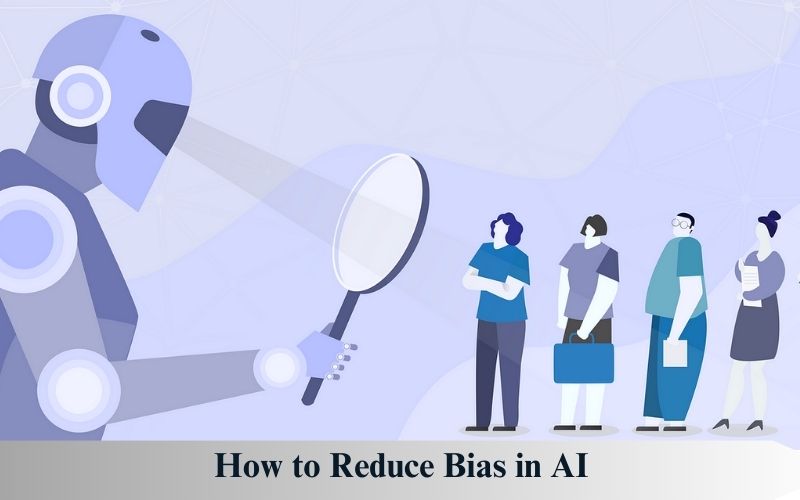In the ever-evolving landscape of artificial intelligence (AI), ensuring fairness and equity has emerged as a paramount concern. As AI systems increasingly influence decisions in critical domains like finance, healthcare, and criminal justice, the presence of bias can exacerbate societal disparities and perpetuate injustices. Fortunately, proactive measures can be taken to mitigate bias in AI algorithms, fostering more equitable outcomes. Let’s delve into the strategies to diminish bias and promote fairness in AI systems and How to Reduce Bias in AI
1. Understanding Bias in AI
Before embarking on the journey How to Reduce Bias in AI, it’s essential to comprehend its manifestations within AI systems. Bias can infiltrate AI algorithms through various channels, including biased training data, algorithmic design, and human interference. Whether it’s historical imbalances in data collection or implicit biases encoded by developers, the ramifications of bias can be profound, reinforcing existing societal prejudices and amplifying disparities.
2. Diverse and Representative Data Collection
At the heart of every AI algorithm lies data, making the quality and representativeness of the dataset pivotal in mitigating bias. To cultivate fairness, it’s imperative to scrutinize datasets for underrepresented groups and ensure diversity across various dimensions, including race, gender, age, and socioeconomic status. By embracing inclusivity in data collection, AI models can better encapsulate the complexities of the real world, diminishing the likelihood of biased outcomes.
3. Rigorous Evaluation and Testing
Beyond data collection, robust evaluation mechanisms are indispensable for uncovering and rectifying bias within AI systems. Employing techniques like sensitivity analysis and fairness metrics enables practitioners to assess algorithmic performance across diverse demographic groups systematically. By scrutinizing AI models through a lens of fairness, developers can pinpoint areas of bias and iteratively refine their systems to yield more equitable results.
4. Transparency and Explainability
Transparency serves as a cornerstone in the quest for unbiased AI, fostering accountability and trust among stakeholders. Embracing transparency entails elucidating the decision-making processes of AI algorithms and disclosing potential biases to end-users. Additionally, fostering explainability empowers individuals to comprehend the rationale behind algorithmic decisions, enabling them to contest unjust outcomes and advocate for fairness.
5. Continuous Monitoring and Adaptation
Bias in AI is not a static phenomenon but a dynamic challenge that necessitates ongoing vigilance and adaptation. Implementing mechanisms for continuous monitoring allows developers to detect and address bias as it evolves over time. By fostering a culture of reflexivity and responsiveness, organizations can cultivate AI systems that evolve in tandem with societal norms, thereby mitigating the risk of perpetuating bias.
6. Diversity in Development Teams
In addition to ensuring diversity in the datasets used to train AI algorithms, it’s equally crucial to foster diversity within the teams responsible for developing these algorithms. Diverse perspectives bring varied insights into the potential biases that may exist within AI systems, helping to identify and address them more effectively. By assembling teams with diverse backgrounds, experiences, and perspectives, organizations can mitigate the risk of inadvertently perpetuating biases during the development process.
7. Ethical Guidelines and Governance Frameworks
Establishing clear ethical guidelines and governance frameworks is imperative for guiding the development, deployment, and use of AI systems. These frameworks should outline principles for fairness, transparency, accountability, and privacy, providing a roadmap for ethical AI implementation. By adhering to established ethical guidelines and governance frameworks, organizations can mitigate the risk of bias and ensure that AI systems are aligned with societal values and norms.
8. Bias Mitigation Techniques
A variety of bias mitigation techniques can be employed during the development and deployment of AI systems to reduce the likelihood of biased outcomes. These techniques include algorithmic adjustments, such as reweighting or resampling training data to address imbalances, as well as algorithmic constraints, such as imposing fairness constraints during model optimization. Additionally, post-processing techniques, such as bias correction algorithms, can be applied to mitigate bias in predictions generated by AI models. By leveraging a combination of these techniques, organizations can enhance the fairness and equity of their AI systems.
9. User Feedback Mechanisms
Implementing user feedback mechanisms can provide valuable insights into the real-world impacts of AI systems and help identify potential sources of bias. By soliciting feedback from end-users, stakeholders, and affected communities, organizations can gain a deeper understanding of how AI systems are perceived and experienced across different demographic groups. This feedback can inform ongoing iterations and refinements to AI algorithms, ensuring that they continue to evolve in ways that prioritize fairness and equity.
10. Education and Awareness
Raising awareness about the implications of bias in AI and providing education on best practices for mitigating bias are essential steps in fostering a culture of responsible AI development and deployment. By offering training programs, workshops, and resources on topics related to bias in AI, organizations can empower developers, data scientists, and other stakeholders to proactively address bias throughout the AI lifecycle. Additionally, promoting public awareness and understanding of the ethical considerations surrounding AI can facilitate informed discussions and decision-making around its use.
Frequently Asked Questions (FAQs)
1. How does bias manifest in AI algorithms? Bias in AI can manifest through various avenues, including biased training data, algorithmic design, and human interference. Whether it’s historical imbalances in data collection or implicit biases encoded by developers, the ramifications of bias can be profound, reinforcing existing societal prejudices and amplifying disparities.
2. Why is diverse and representative data crucial in mitigating bias? Diverse and representative data are instrumental in mitigating bias as they enable AI algorithms to encapsulate the complexities of the real world. By ensuring diversity across various dimensions, including race, gender, age, and socioeconomic status, practitioners can cultivate AI models that yield more equitable outcomes and mitigate the risk of perpetuating societal biases.
3. How can transparency and explainability foster fairness in AI? Transparency and explainability serve as cornerstones in fostering fairness in AI by promoting accountability and trust among stakeholders. By elucidating the decision-making processes of AI algorithms and disclosing potential biases to end-users, organizations can empower individuals to contest unjust outcomes and advocate for fairness.
4. Why is continuous monitoring and adaptation essential in addressing bias in AI? Bias in AI is not a static phenomenon but a dynamic challenge that necessitates ongoing vigilance and adaptation. Implementing mechanisms for continuous monitoring allows developers to detect and address bias as it evolves over time, fostering a culture of reflexivity and responsiveness that mitigates the risk of perpetuating bias.
5. How can organizations prioritize mitigating bias in their AI initiatives? Organizations can prioritize mitigating bias in their AI initiatives by embedding fairness considerations into every stage of the AI development lifecycle. From data collection and algorithmic design to evaluation and monitoring, fostering a holistic approach to fairness enables organizations to cultivate AI systems that uphold principles of equity and justice.




